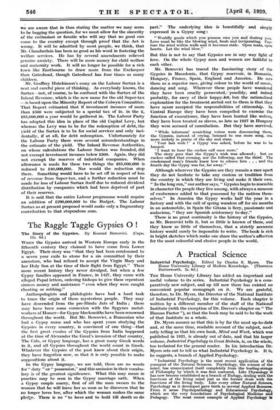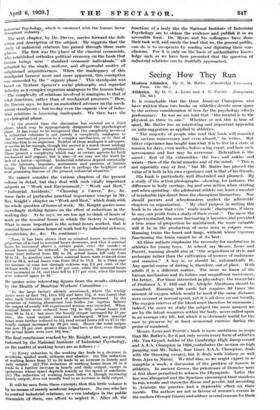A Practical Science Industrial Psychology. Edited by Charles S. Myers.
The Home University Library of Modern Knowledge. (Thornton Butterworth. 2s. 6c1.) Tam Home University Library has added an important and useful volume to its series. Industrial Psychology is a com- paratively new subject, and up till now there has existed no convenient popular monograph on it. We are grateful, therefore, to Dr. Myers, the Director of the National Institute of Industrial Psychology, for this volume. Each chapter is written by a different member of the staff of the National Institute (with the exception of Dr. Drever's chapter on " The Human Factor "), so that the book may be said to be the work of that Institute as a whole.
Dr. Myers assures us that this is by far the most up-to-date and, at the same time, readable account of the subject, mod- estly telling us that his own book, Mind and Work, which was published in 1921, is already out of date, and that his larger volume, Industrial Psychology in Great Britain, is, on the whole, too technical for the general reader. In his introduction Dr. Myers sets out to tell us what Industrial Psychology is. It is, he suggests, a branch of Applied Psychology.
" Industrial Psychology is the most recent application of the youngest of the Natural Sciences. Psychology, the science of the mind, has emancipated itself completely from the leading-strings of Philosophy by which it was first nurtured. Like Physiology it has now become established as a branch of Biology, dealing with the functions of the living mind just as the former deals with the functions of the living body. Like every other Natural Science, Psychology as it developed gave birth to several Applied Sciences. From it arose Psychopathology and Educational Psychology, which are the very foundations of Psychological Medicine and Pedagogy. The most recent example of Applied Psychology is industrial Psychology, which is concerned with the human factor throughout industry."
The next chapter, by Dr. Dreyer, carries forward the defi- nition and description of the subject. He suggests that the study of industrial relations has passed through three main phases. ha The first was the phase of the classical economists, who established orthodox political economy on the basis that human beings were standard economic individuals," all actuated by the single, uniform, and all-powerful motive of enlightened acquisitiveness. When the inadequacy of this standpoint became more and more apparent, this conception was succeeded by the ' organic phase." This standpoint was based on Herbert Spencer's social philosophy and regarded industry as a complex organism analogous to the human body.
The complexity of relations involved is analogous to that of vital functions, rather than of mechanical processes." Here, Dr. Dreyer says, we have an undoubted advance on the mech- anical standpoint : but to-day even the organic view of indus- trial relations is becoming inadequate. We then have the psychological phase.
" At the present time the discussion has entered on a third phase, which may be appropriately designated the psychological phase. It has come to be recognized that the complexity involved in industrial relations is not merely a complexity analogous to that of mechanical process in a complex mechanism, or to that of vital function in an organism. Neither of these analogies is adequate, or carries us far enough, though the second is a much closer analogy than the first. The related elements are human personalities. These present a complexity which may in certain aspects bo both mechanical and organic, but is also—if we may use the word for lack of a better—spirituaL Industrial relations depend essentially on the interests, impulses, sentiments and passions of human beings. The realization of this fact is perhaps the brightest and most promising feature of the present industrial situation."
We cannot consider the various chapters of the present volume in detail, but they deal with such vitally important subjects as " Work and Environment," "" Work and Rest," " Industrial Accidents," " Choosing a Career," &c., &c. Some facts of particular practical importance emerge in Mr. Rex Knight's chapter on " Work and Rest," which deals with the whole question of hours of work. Mr. Knight quotes some exceedingly striking figures on the effect of reductions in the working day. As he says, we are too apt to think of hours of work as the nominal hours in which the factory is working. What is more important is the actual hours worked, that is nominal hours minus hours of work lost by industrial sickness, Absenteeism, &c. He continues :- " Now, it has been shown that as nominal hours increase, the proportion of actual to nominal hours decreases, and that if nominal hours be increased above a certain point, even the number of actual hours may be reduced. In one instance, though nominal hours were reduced from 631 to 54, actual hours fell only from 56 to 51. In another case, when nominal hours were reduced from 62.8 to 56.5, actual hours rose from .50.5 to 51.2. In a third case the amount of time lost through sickness was 2.8 per cent. of the 46-hour week ; this rose to 3.85 per cent. when the nominal hours were increased to 54, and then fell to 2.77 per cent. when the hours were reduced again to 46."
He quotes some interesting figures from the results obtained by the Health of Munition Workers' Committee :— " in the large factory already mentioned, where the weekly hours were at first 744, then 634 and later 554, it was found that after each reduction the speed of production increased. In the operation of turning aluminium fuse bodies (on capstan lathes) the output of nearly 100 experienced women was recorded. When nominal hours were reduced from 744 to 634, actual hours fell from 66 to 54.4 ; but since the hourly output increased by 21 per cent., the total output remained unchanged. When nominal hours were further reduced to 554 (and actual hours fell to 47.5) the hourly output increased by 29 per cent. Hence the total output was now 13 per cent. greater than it had been at first, even though the actual hours were now 184 less."
The final conclusions reached by Mr. Knight, and, we presume, endorsed by the National Institute of Industrial Psychology, on the matter of working hours are as follows :— " (i) Every reduction in the working day leads to a decrease in accidents, spoiled work, sickness and absence. (ii) The reduction of working hours from 12 to 10 leads to an increase in hourly and daily output. (iii) The reduction of working hours from 10 to 8 leads to a further increase in hourly and daily output, except in operations whose speed depends mainly on the speed of machines. (rv) The reduction of working hours below 8, though increasing hourly output, does not usually lead to an increase in daily output."
It will be seen from these excerpts that this little volume is by no means of merely academic importance. No one who has to control industrial relations, or even indulges in the public discussion of them, can afford to neglect it. After all, the functions of a body like the National Institute of Industrial Psychology are to obtain the evidence and publish it in an accessible form. Dr. Myers and his colleagues have done their task well, and surely the least that we, the general public, can do is to co-operate by reading and digesting their con- clusions. For it is only on the basis of authoritative know- ledge such as we have here presented that the question of industrial relations can be fruitfully approached.







































 Previous page
Previous page